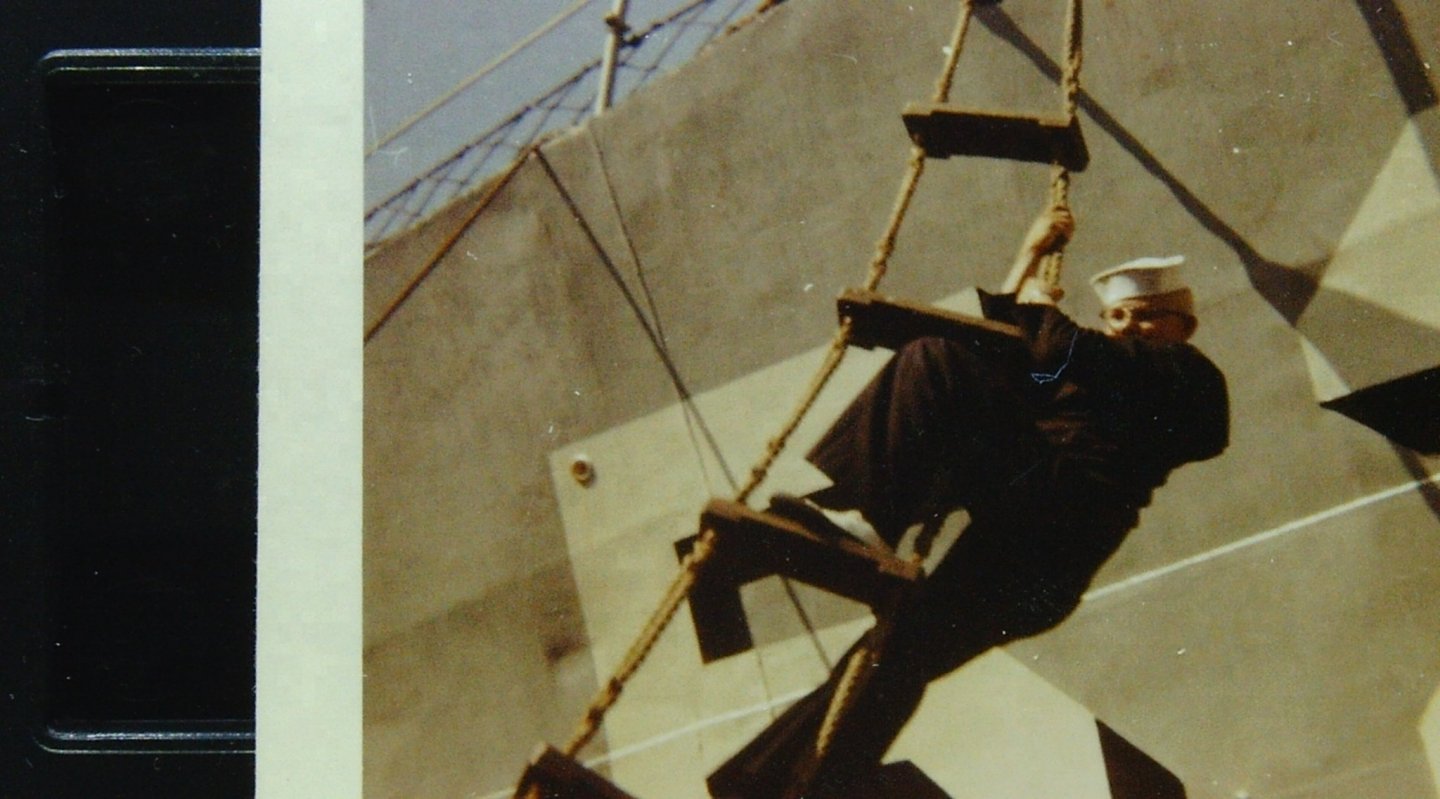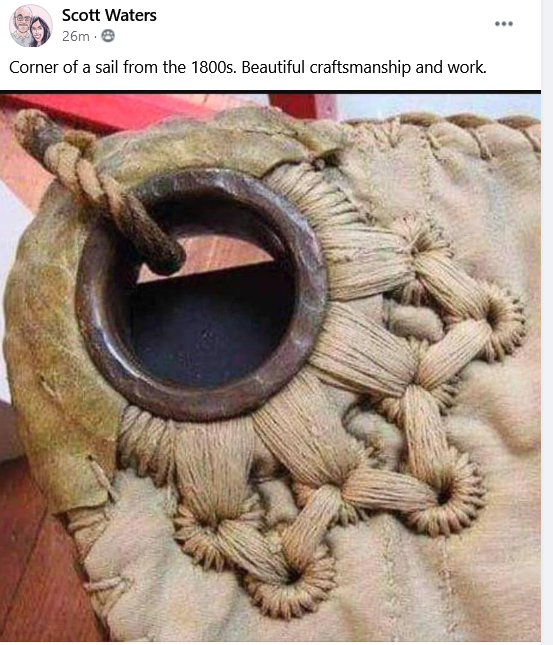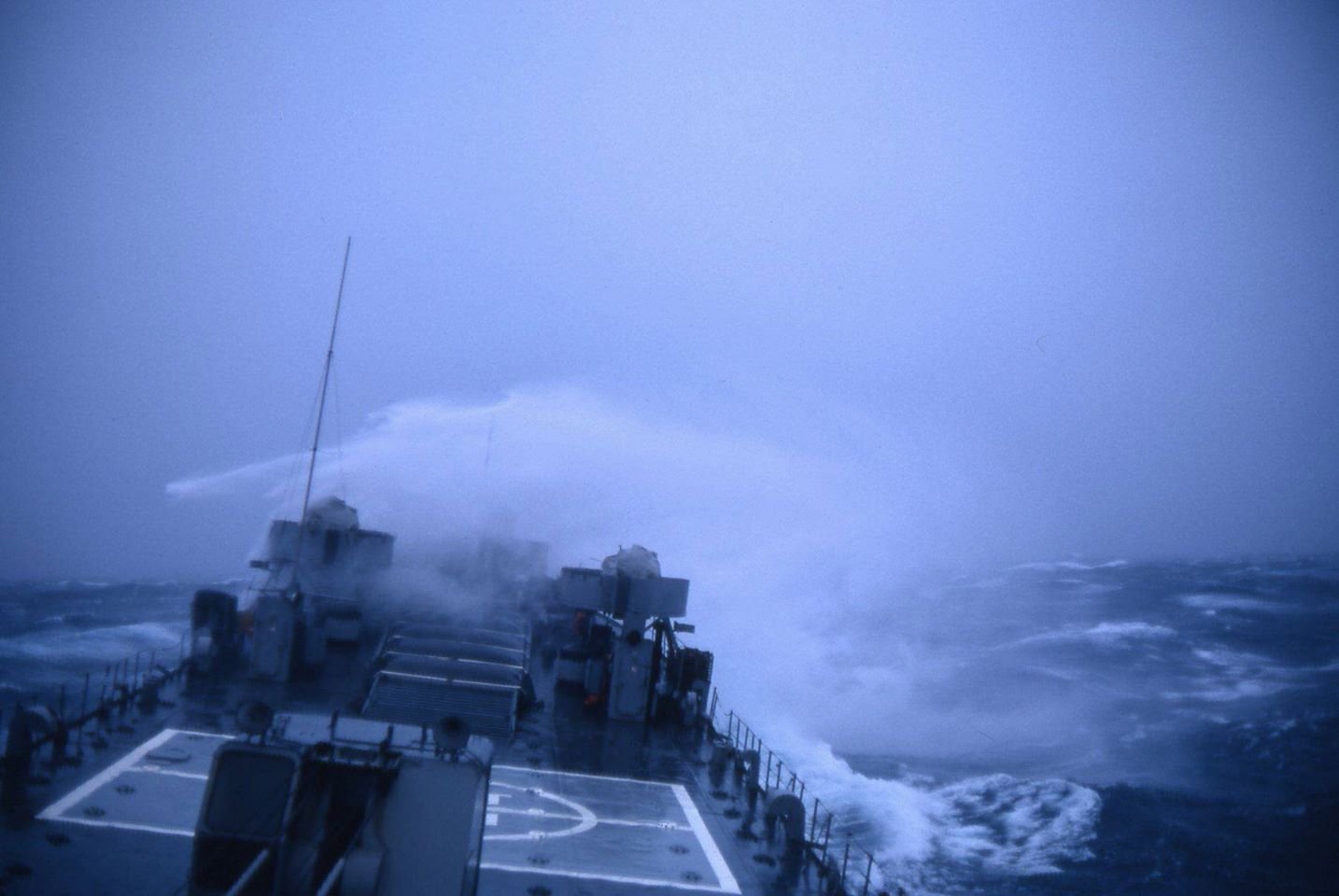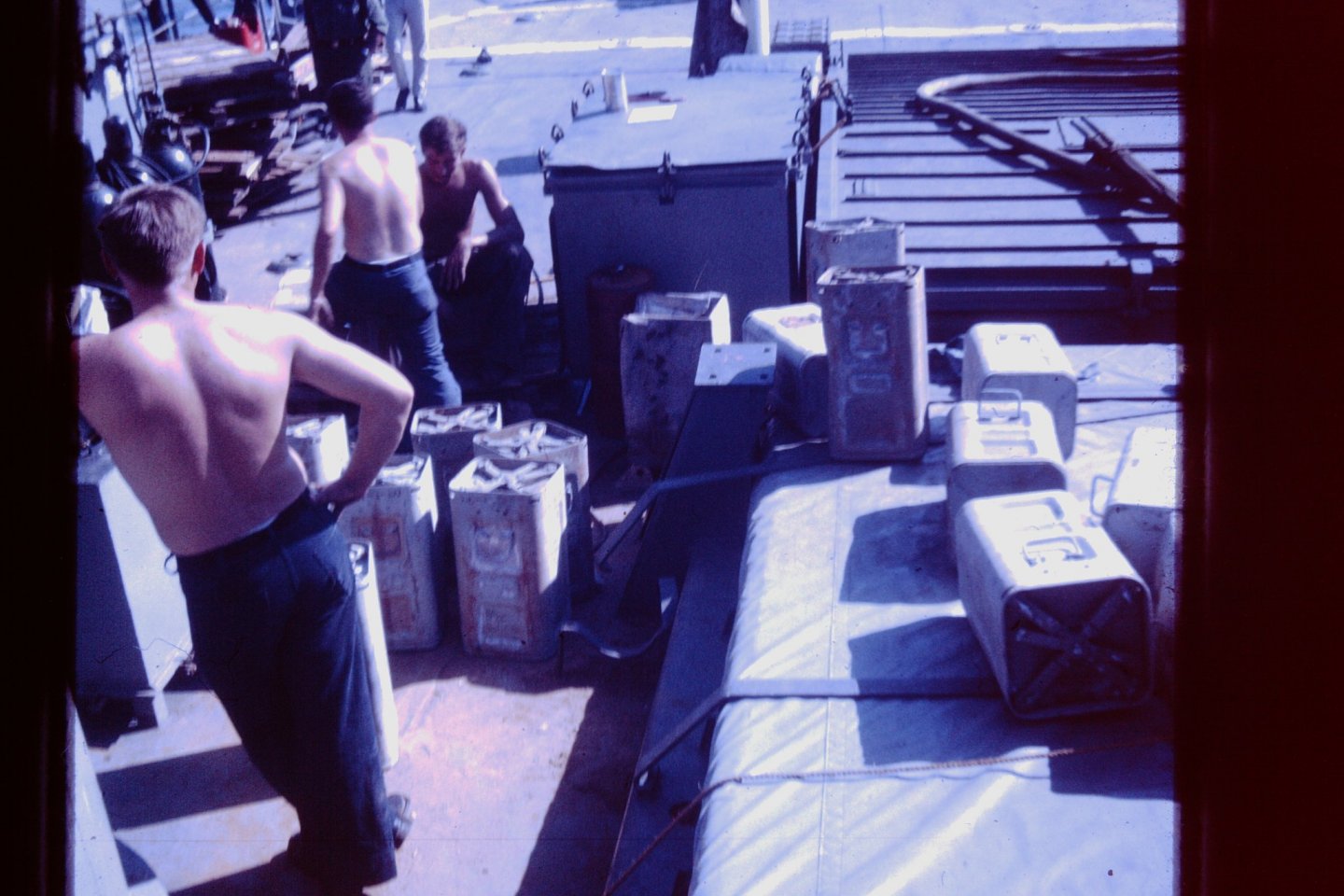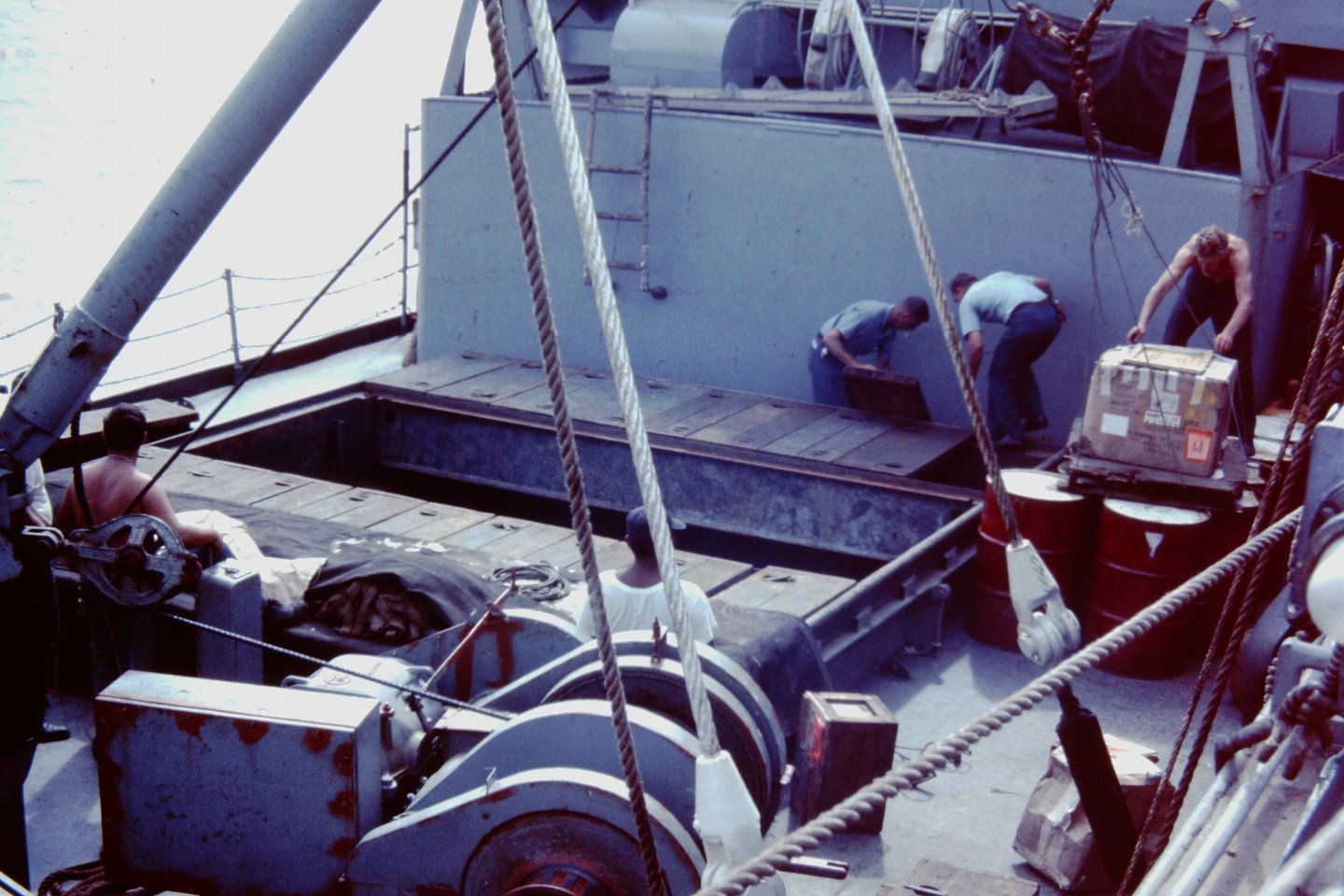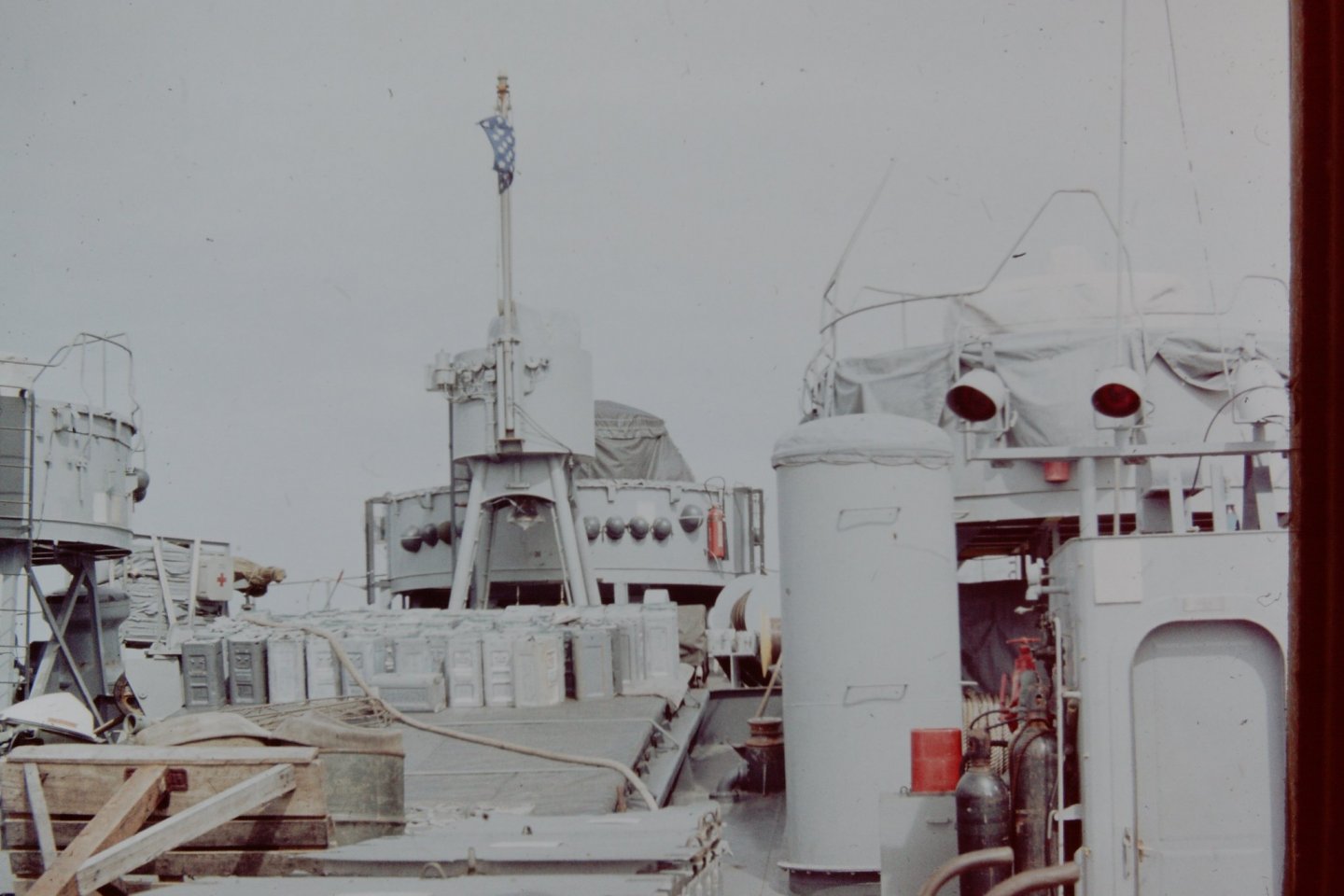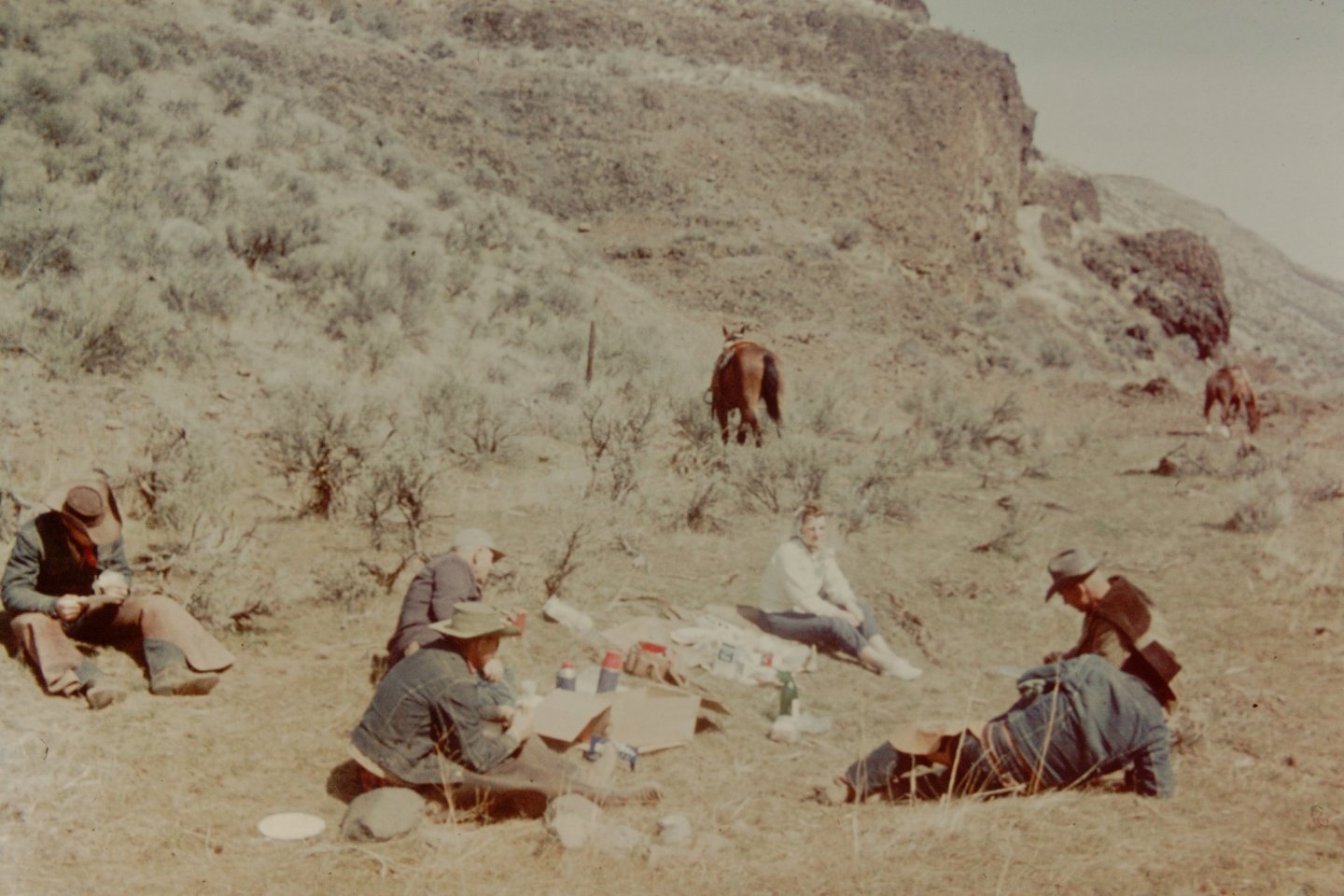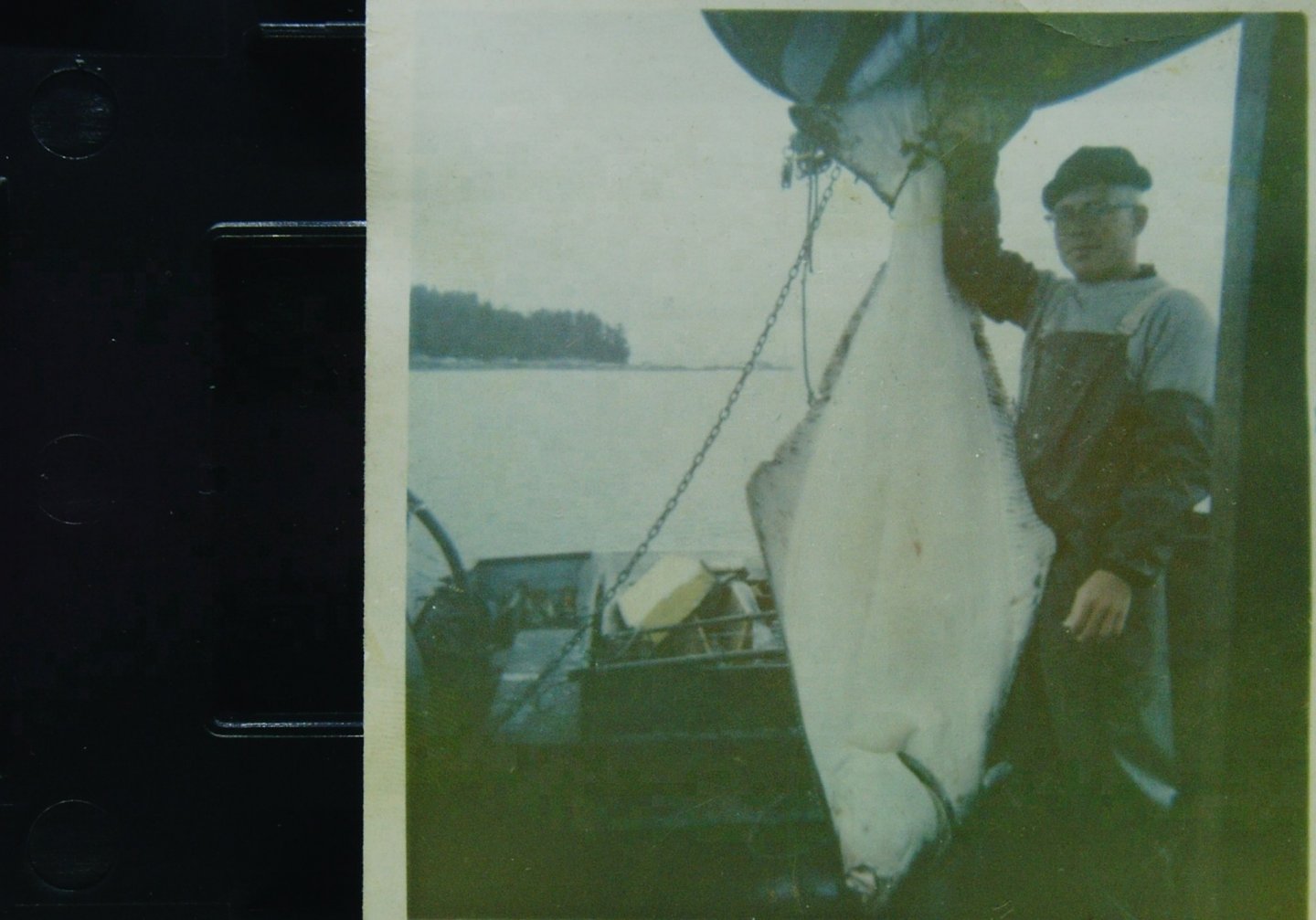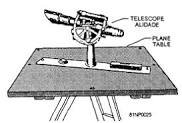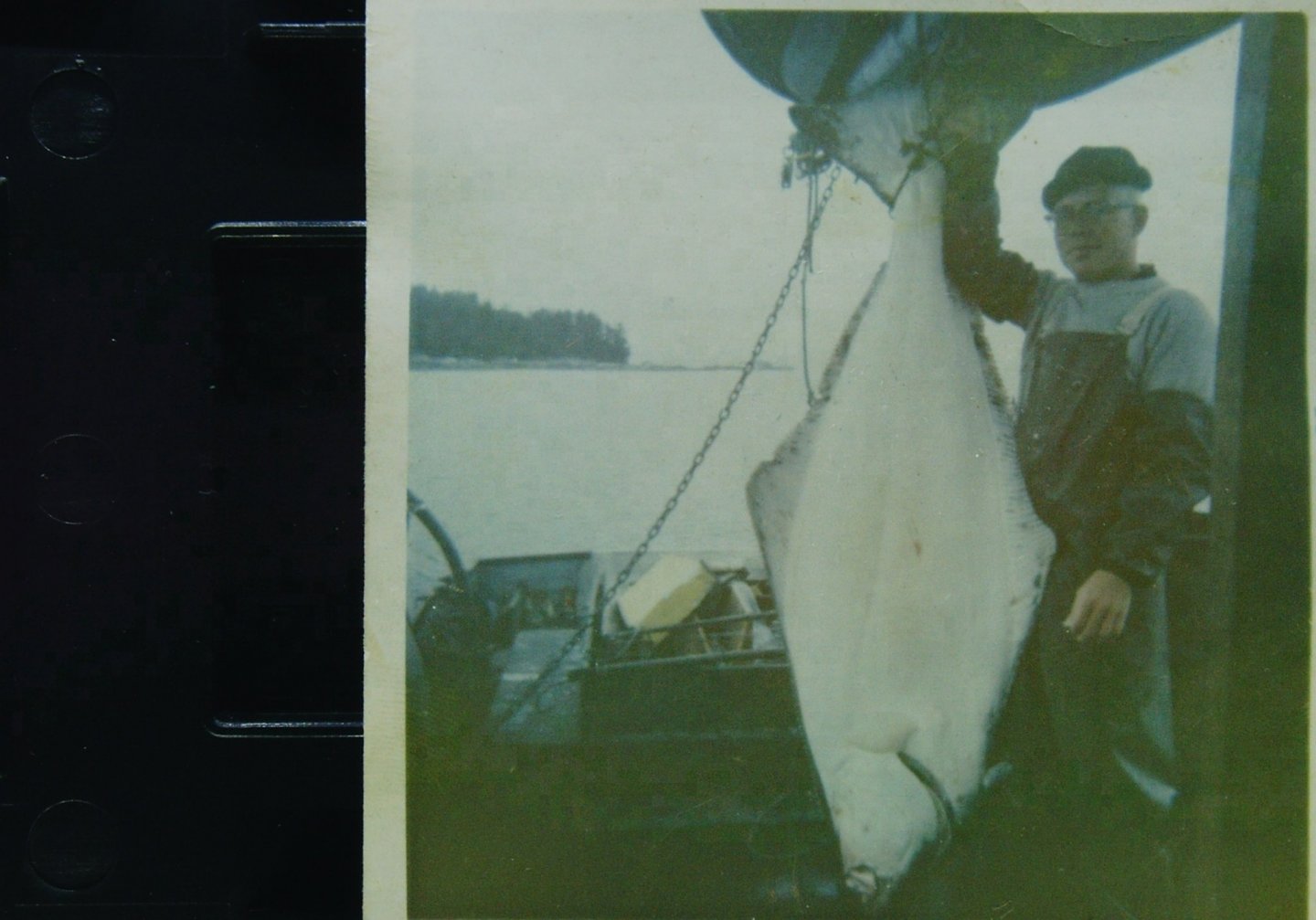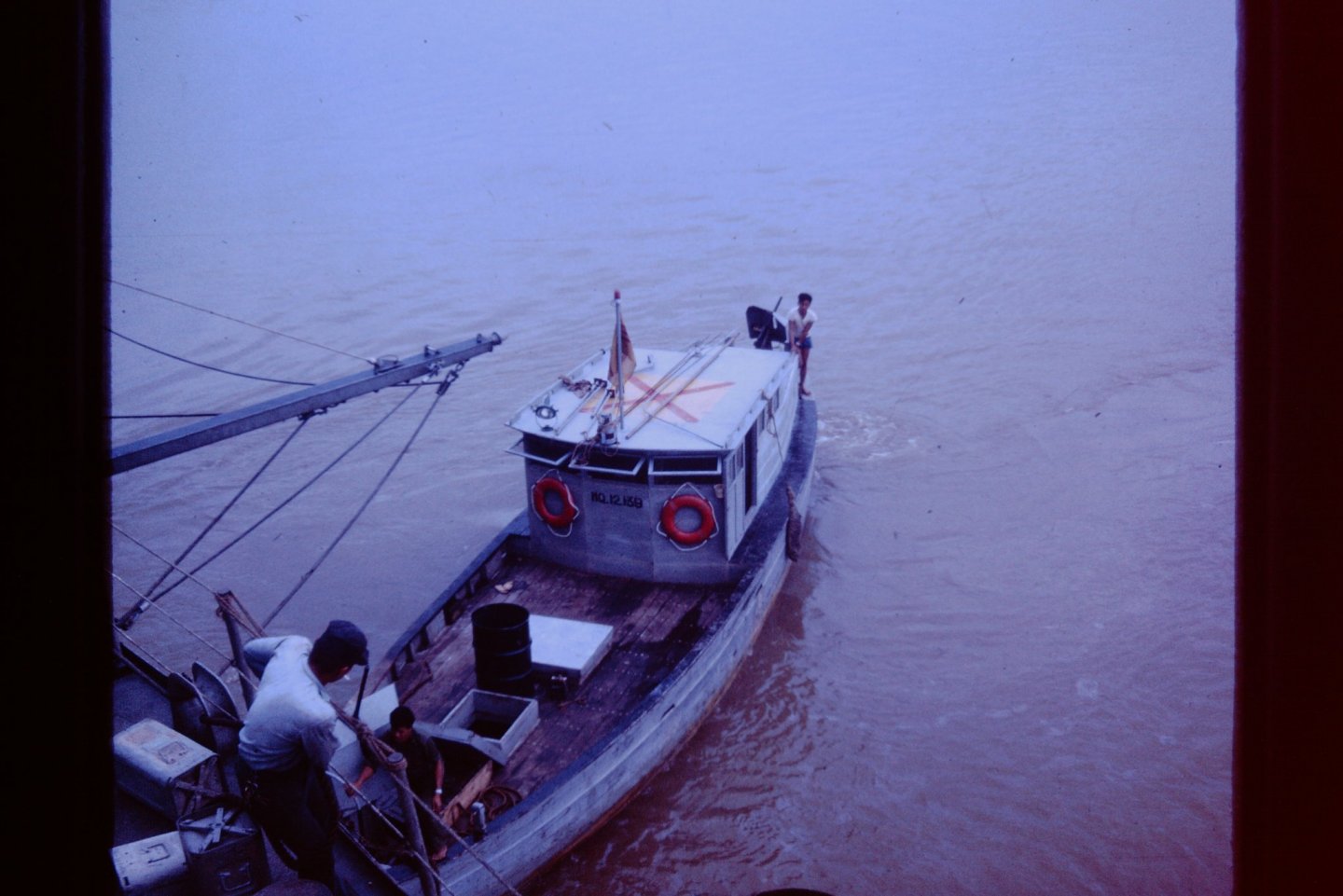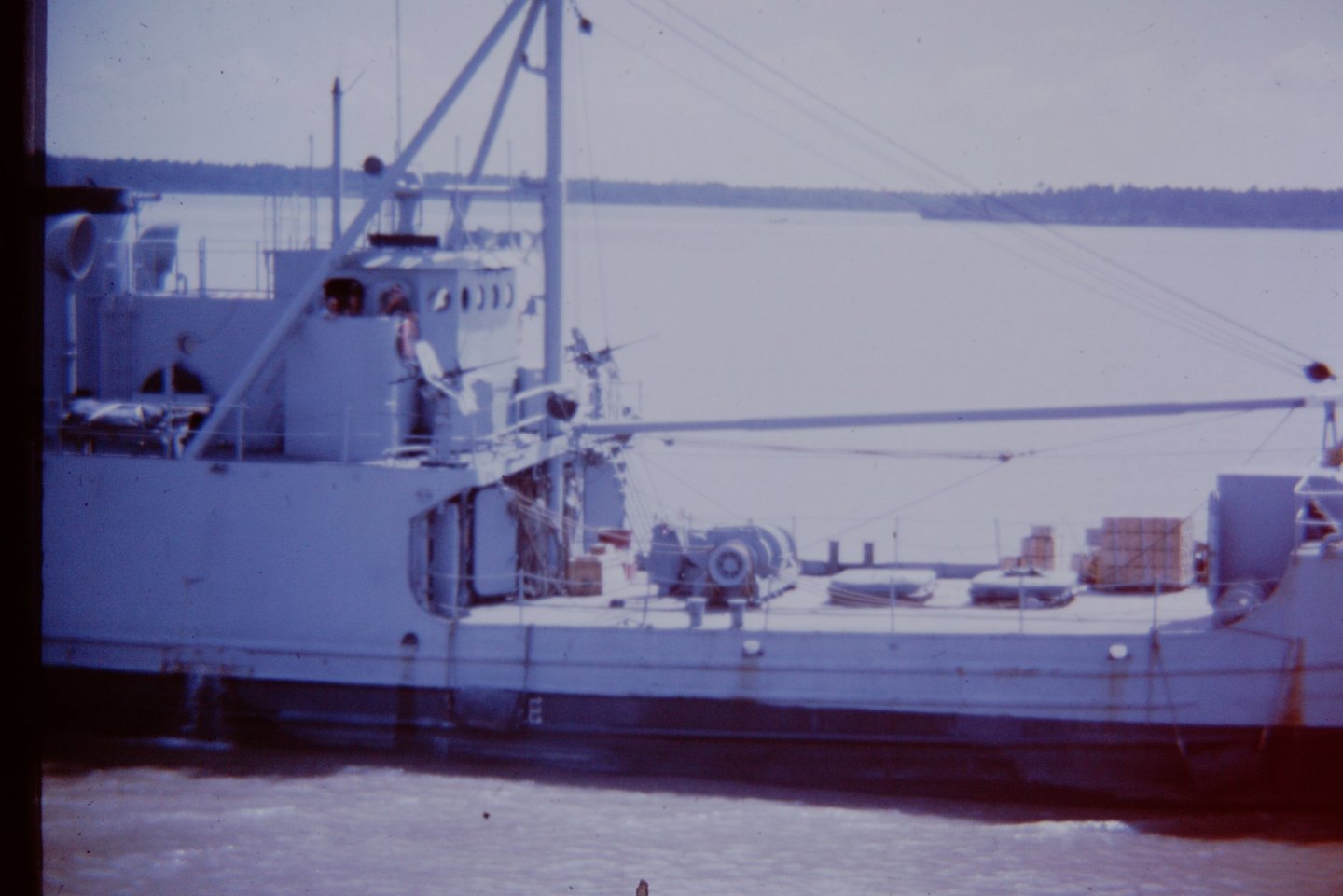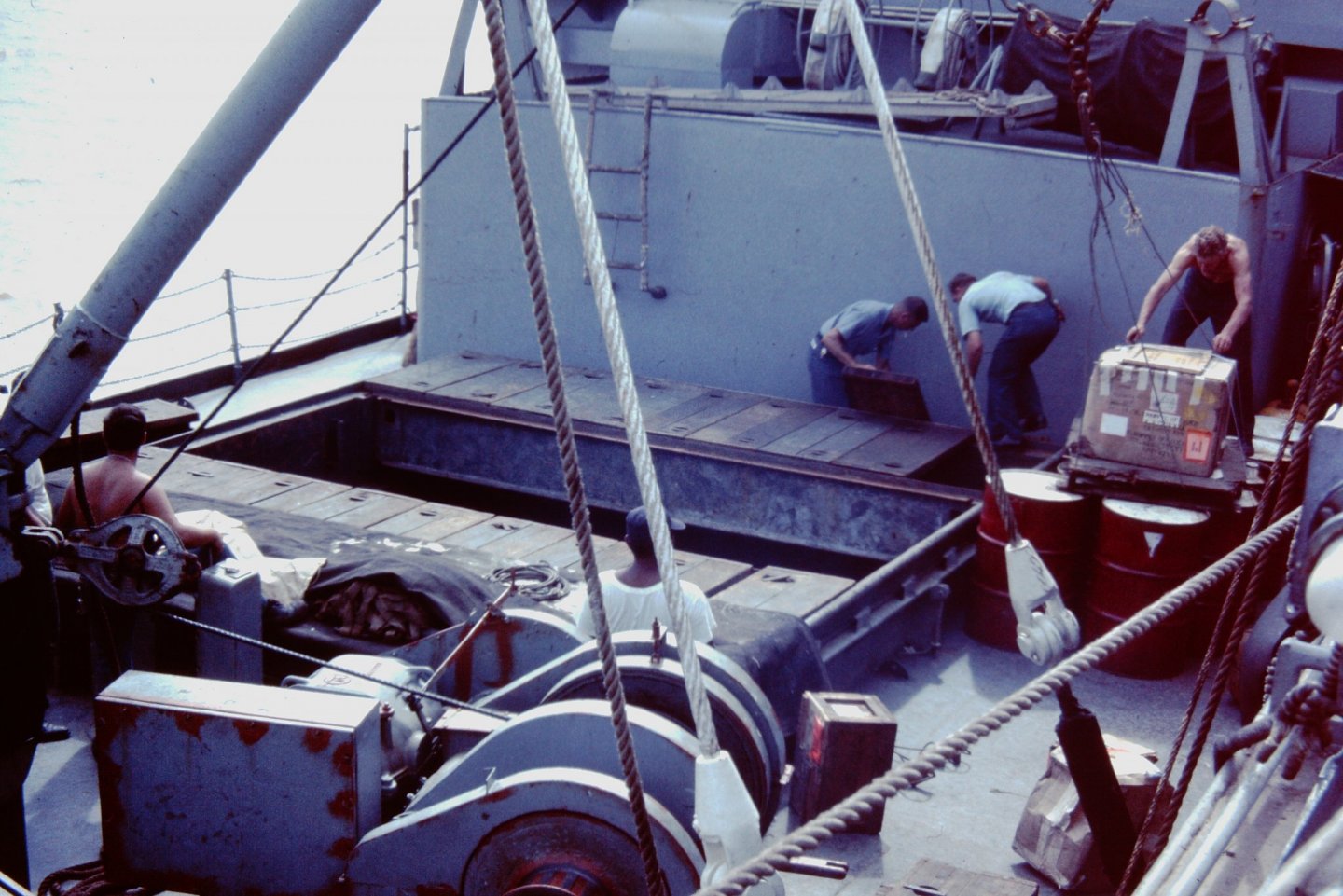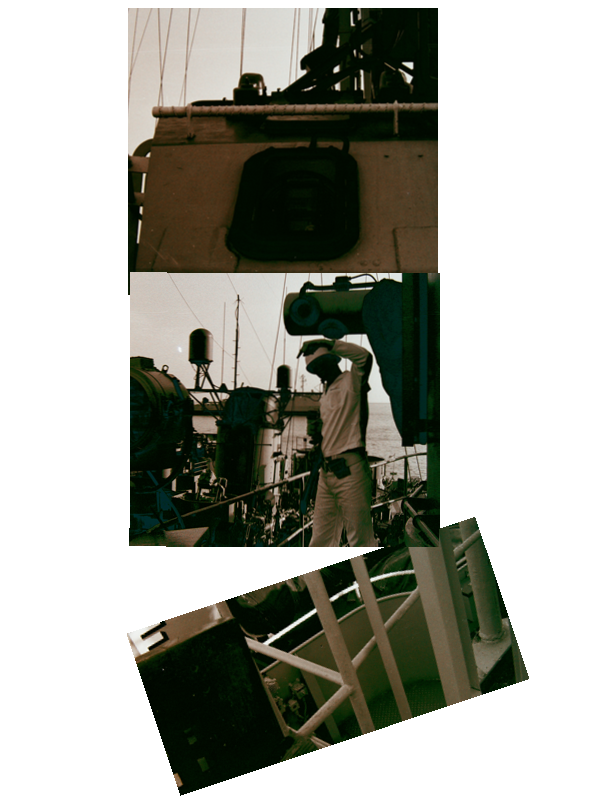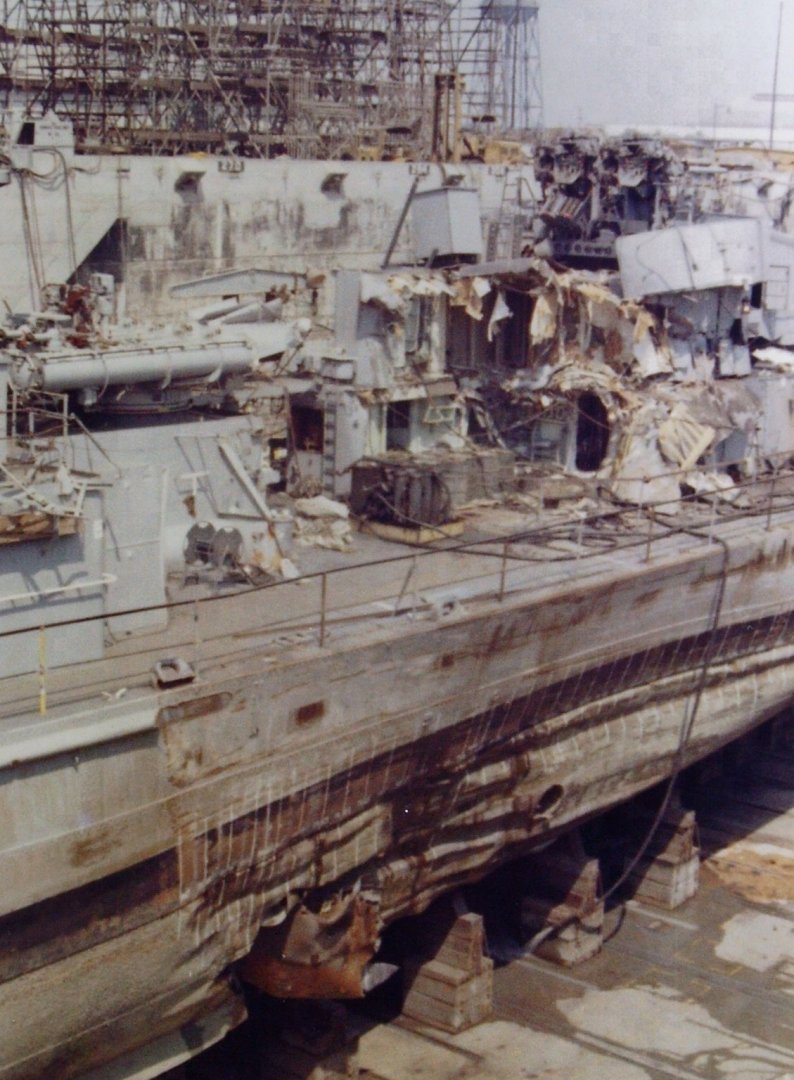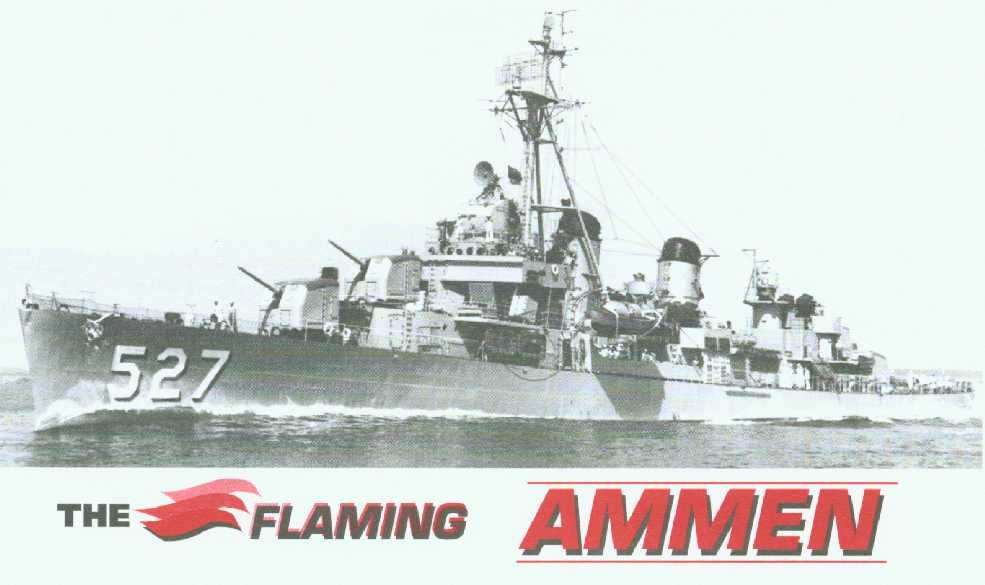-
Posts
1,171 -
Joined
-
Last visited
Content Type
Profiles
Forums
Gallery
Events
Everything posted by jud
-

Fighting ladders
jud replied to dafi's topic in Discussion for a Ship's Deck Furniture, Guns, boats and other Fittings
Rope ladders, even one's with wood or iron rungs have a terrible characteristic of when hanging freely to put your feet somewhere at or over your head level when climbing them. Several methods to avoid that, one is securing both ends of the ladder so it remains taught when being used. Another is to let it rest on a bulkhead or other fixture, restricting it's movement, problem is your toes have nowhere to go to purchase the rungs, no matter what they are made from, so spacers are used in those situations, oversized spools on the ends of the rungs are common. The free hanging ladders are used by climbing the sides to keep your feet under you. Photo, me 1960 climbing out of the Whaleboat of the USS Ammen DD 527 when the Squadron was swinging on a buoy in San Diego, was the bow hook until I wiggled my way into the Gun Gang, the boat was sheltered between the bows when not in use. Throwing a rope ladder at a choke point, be it a hatch or as access to another weather deck will work, but it requires thought about how fast and how many men you need to move or you will not have those men where you wanted them quickly. -
Having been around large guns on ships and seen the damage shock waves from Muzzle Blast can do, my guess would be that those with experience would secure them up against a stopper or held hard against the hull so they could not move when the guns were fired. Suspect most will tell you to leave them out because that is what they have seen in models for years. Hard against the hull or against a stopper will get you more disagreements than leaving them to flap in the wind as is the norm in the modeling world when they are modeled on the hull. Seems like those upper covers were removed and stored below when exercising the guns, probably experience dictated that solution.
-
Gravity is a constant within limited areas so a water level unless effected by friction and wind will always show true at both ends. Plum Bob strings will also hang parallel unless disturbed by air movement within the area of a hulls construction. Those two things provide the repeatable constants for building anything and they are perpendicular. Suspect they, with few exceptions were the only constants in old or current ship building. KISS principle comes to mind. en.wikipedia.org › wiki › KISS_principle KISS, an acronym for keep it simple, stupid, is a design principle noted by the U.S. Navy in 1960. The KISS principle states that most systems work best if they are kept simple rather than made complicated; therefore, simplicity should be a key goal in design, and unnecessary complexity should be avoided.
-
Tie the first and last knot with the bitter end tucked under the outside turn making the clove hitch into a constrictor knot. don't pull tight or trim until the shrouds are adjusted.
-
These are the best of Cargo Hatch Cover Photos I took in 66-67 aboard 2 different 542 Class LSTs in the South China Sea or on a Delta river, except the supply ship that kept us in feed and ammo. The photo of the wet forward hatch taken aboard the Clark County LST 601, a ship I was part of the recommissioning crew 65-66, is over the main deck ramp to the tank deck, on a slope but typically closed as all hatches were that I was ever around. Notice the white water, not here, but green water sometimes got up there, hence the batons over the top from side to side to prevent wind and water from lifting the covers and boards underneath, this was also done on the main deck hatch. I show how those batons were attached aboard the Harnett County LST 821, they were two piece, connected by turnbuckles so they could be loosened to remove and tighten up again when placed across the closed hatch. Included the other photo to show that those closed hatches were often used as deck space, here we are storing empty 40MM Bofors cans in hopes we could offload them before we had to throw them overboard. The cargo ship hatch, is partly open so you can see the boards and cross members, the clips outside the hatches are visible along with a sack of wedges used with the batons and clips to secure the covers.
-

Cannon Alignment
jud replied to JohnB40's topic in Discussion for a Ship's Deck Furniture, Guns, boats and other Fittings
Remember that the gun does not move until after the projectile has left the bore so we are not talking about an engine delivering long term and steady force. When the projectile leaves the bore, it's all over folks, no more force attempting to overcome inertia of a stationary mass, what remains is working against the buffer action of the training tackles and whatever constraints the carriage and it's mass bring to bare, all energy absorbing masses and friction devices acting as restraints while absorbing diminishing energy. Bothers me not letting the tackle act as a brake. Recoil up to today is absorbed without harm just as it was done then, more energy today, yep. but time, distance and mass are still the controlling elements used to absorb energy delivered a blow. 6ft/sec means little when dealing with milliseconds absorbed over time and distance. -
Don't think any structural shortages were employed in Fire Ships, they needed to be sea worthy and capable of serving the fleet, sometimes for years. Would expect them to look like any normal vessel of their size and rig. Going aboard and the truth might be seen, expect them to filled with the combustibles of the day, stored for ready use and much of it. It would be the combustibles that set them apart from the rest of the fleet.
-

What were your first tools as a child?
jud replied to FlyingFish's topic in Modeling tools and Workshop Equipment
Had joined the Cub Scouts and really wanted a Boy Scout Knife because it was so neat with all sorts of different blades and I could join in on the toothpick making process of Dad and Grandad as they discussed the world events while soaking up the sun. One night, the dog got into it with a skunk and Dad shot the skunk. The bargain was that if I buried the skunk, I would get the knife. Got the knife, also learned that when burying a skunk, dig the hole before retrieving the skunk. -
The Cat tackle is used to lift the anchor from the water after being hoisted, can also be used to hold and control it while the rigging for stowage was put in place, it is not used to let go by releasing the hook on the Cat Tackle. To be used to let go, a pelican hook or similar device would be needed on the Cat Tackle instead of the hook you find there. The cat tackle is also used to lift the anchor to a quick release fitting attached to the Cat, then removed and two-blocked out of the way while the anchor hangs from the quick release device, when ready, it is let go from there, the cable follows it down being fed by the measured and flaked out cable on deck led through the Hawse Hole. Never used a Cat, but have anchored by tossing the anchor by hand and lifting it the same way, have used a sledge on the pelican hook aboard a Fletcher Class Destroyer to let go, in that case the chain ran out the Hawse, fed around the capstan from the chain locker below. Anchor cables unless very small were not wrapped around the drums of Windless or Capstans and allowed to run freely when letting go, until brakes became the norm to control them, by then it was mostly anchor chain. Good post, just a little more research with some study of the laws of physics needed. Loosening the brake to much and then overheating in an attempt to regain control, modern, but the forces at work are the same and the folly of letting capstans and windlasses to run free can be seen. https://bangshift.com/bangshiftxl/runaway-anchors-watch-what-happens-when-ships-lose-the-handle-on-100-tons-of-iron/
- 24 replies
-
- anchor handling
- schooner
-
(and 1 more)
Tagged with:
-
Guns are not rigged for firing, sponges, rammer's and other loading and firing gear is not to be seen, blocks with lines and other gear scattered about. Would suspect those are capstan bars, keeping them handy, yet out of the way and not gun equipment at all. Modern man often jumps to conclusions, in an attempt to group unrelated objects together in old photos or modern arraignments of unrelated old equipment and gear. Capstans are used for more than lifting the anchor on most vessels.
-
Drafting by hand is an art form and the lettering is more noticeable than the line work on all forms of it. Other than Mechanical Drawing Classes in High School, my Professional experience was with Civil Engineering and Survey Drafting by hand. The trick to good usable drawings was the correct dimensions and accurate data in the tables used to support the drawing details. Someone had to provide that data or you did the Math Yourself, scaling was not good enough. We did our Survey Drawing by plotting grid points and connecting the dots, to do that we needed coordinates, we used Rectangular and Polar both and computed them by hand using Log and Trig Tables, 'not Slide Rules', then the HP 35 came along, beginning the race to computers using COGO. A good Coordinate Geometry Program, 'COGO', was a God Send, from it Cad developed and refined enough to be useful. Hand Drafting was a mighty tool for a long time, but it seldom stood alone. If you wish to design or build from your own plans, uses cad, or learn some Geometry and Trig to run and intersect vectors for dimensions, full size, your drawings with hand fitting oversized parts will work as it has for years.
-

coral fishing boat by maurino
jud replied to maurino's topic in - Build logs for subjects built 1901 - Present Day
Nice work. Keep some of your hull finish on hand, going to need some touch up when you modify the Gudgeons and Pintals so the rudder will swing. -
Probably thousands of different ways to secure the small boats different vessels carried as long as they are secure. Stowed with the keels down, I would expect a cover to be secured and vented to protect the interior from water and damage from the sun, would not find it amiss if the keel was up to be covered. There are many hitches using loops to create a tackle to draw tension into ropes, what most call the truckers hitch is one many use today.
-
If you have ever chased anything massive that has came adrift at sea, you will understand why the large Breaching Rope was in place, not to stop recoil, but to stop the gun from becoming a massive ram powered by gravity. Would only expect the guns to make the breaching taught if the gun was fired on the up-roll and gravity was assisting. Much of the forces of recoil would be consumed in getting the mass moving, once that was done, all the recoil forces would be expended and coasting to a stop would be the norm. Putting a gun crew down from a near hit, would place that gun out of control and depending on the seas, on it's wheels or not would have little effect on it potential travels, hence the heavy breaching keeping that gun from taking others out. The length has been well defined and explained above
-
Looks like a good model from here. There have been some well researched Endeavour's done on this Site, suggest they be reviewed and perhaps some modifications made topside. One I like was the crossover at the Tiller, not being merely a convenience for old stiff seamen but with all the mapping done by Cook was, infact, a platform to place a Plane Table and Alidade used for mapping, that would require more fore-aft distance than the model currently is equipped with. I have used a Plane Table and Alidade to run miles of "P" Line, ( preliminary Line), for road designed using aerial photos and the design printed on mylar for field use running the Centerline on the ground, also have used it to create Topographic Maps where precision was not critical so understand how Captain Cook might have used that space to his advantage. That experience and having made my living as a professional Land Surveyor makes that research more valid than other explanations for that crossover, these were active men and did not need the thing for crossing from side to side. Sore back and burning eyes from glare when using.
-
Those who served aboard the Fletchers and served with the WW2 Vets and Korea Vets who rode those ships in combat are entitled to find fault with the details, including the acting.
-
Not Hatch Boards, but a common way to cover smaller hatch combings, done this way aboard the Salmon Troller Cape Race and the Junks. Standing on our Hatch Cover showing off my big fish, the Halibut I caught using a jig from the Cape Race in SE Alaska 1965, rode her from Bellingham up to SE Alaska, fished the season and brought her back to Bellingham, we jigged for halibut when the King Salmon wern't biting. The other photo was 1967 on the Bassac river, This boat is smaller than the Junks used by the RVN Navy to patrol. This one is a Popular Forces boat, they were alongside to collect empty 40MM cans for bunker construction, put them in place, full with mud and secure the lid, we usually had to throw them overboard because we had no more room to store them, happy these found a home. .
-
Depends on the hatch board and the intended method of lifting. The most common mistake made by modelers when creating lifting hardware for hatchboards, is that they an not made to rest flush with the surface of the board. Hatches are battened down after covering with an old tarp or two or three, then the top weatherproof cover is put in place and battened down, don't want lumps to trip over or to wear a hole in the tarps, so flush with the lifting hardware, regardless of type.
-
Gonna tell you a story, not very long that took place on a Fletcher Destroyer, (USS Ammen DD 527) chasing Soviet Submarines off the California Coast at Condition 2, all about a potato, a Captain and a kid not long out of boot, who found himself standing the Mid watch in the Main Battery Director manning the Pointers station and also trained the thing by reaching across into that unmanned station. At 17 and no midrats those midwatches are hungry affairs. Coming off a ranch and cooking for myself often , also snacking on raw spuds, the spud locker was my Idea of salvation, I swiped two nice ones. About 0130, one was consumed and it filled me, so the plan to consume all the evidence was foiled, what to do with that other spud? Then it hit me, I was on the top of the superstructure and no one was looking, had control of the training mechanism and manual movement made no noise. Trained her around to Starboard, opened the overhead hatch, climbed on the seat and let fly. falling off the seat as I let go, spud ricichead off the hatch and headed toward the bridge wing where sudden surprised talking commenced, the wheel on that hatch never turned so fast and the director was soon pointing forward. I assumed the attitude of a hiding mouse, hoping I would not be traced as the culprit. All was well until the next morning when I found out that spud had hit the Captain on the head, the Repair Party that was mustered near the spud locker were restricted to the ship until the guilty came forward and owned up to his eval deed. Could not let that stand so I told the Chief Boatswain Mate what had happened. No one suspected me and could have let it fade in to history but because I didn't and the Captain and the Chief Boatswain Mate had a sense of humor, I escaped without punishment,other than all aboard knew about my great potato caper. Took some photos of the director hatch, flight path and target area, this was 1960, 60 years ago, how time flies.
-
Photo 1960 USS Ammen DD 527, our main decks were painted with sand added to the walkways, non skid stick-ons were used in the superstructure and below decks, a the foot of ladders, both sides of watertight doors and around hatches and scuttles, etc. Photo is after a weeks cleanup after a collision at sea, 19 July 1960. Internet has lots about the wreck.
-
Fletchers were not available for that duty in 42, the first one built were not commissioned until well into 1941 and were sent to the Pacific where their long legs and weapons could be utilized. From other sites frequented by those who served on those ships, most were disappointed, to many errors and missing details in the computer renderings. Those looking for accuracy were disappointed, those who cared more for the action seemed to enjoy the film. I will not be signing up to watch. The One I rode was the USS Ammen DD 527, her teeth were cut in the Aleutians.
About us
Modelshipworld - Advancing Ship Modeling through Research
SSL Secured
Your security is important for us so this Website is SSL-Secured
NRG Mailing Address
Nautical Research Guild
237 South Lincoln Street
Westmont IL, 60559-1917
Model Ship World ® and the MSW logo are Registered Trademarks, and belong to the Nautical Research Guild (United States Patent and Trademark Office: No. 6,929,264 & No. 6,929,274, registered Dec. 20, 2022)
Helpful Links
About the NRG
If you enjoy building ship models that are historically accurate as well as beautiful, then The Nautical Research Guild (NRG) is just right for you.
The Guild is a non-profit educational organization whose mission is to “Advance Ship Modeling Through Research”. We provide support to our members in their efforts to raise the quality of their model ships.
The Nautical Research Guild has published our world-renowned quarterly magazine, The Nautical Research Journal, since 1955. The pages of the Journal are full of articles by accomplished ship modelers who show you how they create those exquisite details on their models, and by maritime historians who show you the correct details to build. The Journal is available in both print and digital editions. Go to the NRG web site (www.thenrg.org) to download a complimentary digital copy of the Journal. The NRG also publishes plan sets, books and compilations of back issues of the Journal and the former Ships in Scale and Model Ship Builder magazines.


